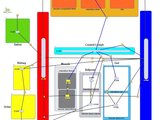Diagnostic PBPK model for S100B
Cite As
Damir Janigro (2022). Diagnostic PBPK model for S100B (https://www.mathworks.com/matlabcentral/fileexchange/106145), MATLAB Central File Exchange. Retrieved February 28, 2022.
Published on line as Murcko R, Marchi N, Bailey D, Janigro D. Diagnostic biomarker kinetics: how brain-derived biomarkers distribute through the human body, and how this affects their diagnostic significance: the case of S100B. Fluids Barriers CNS. 2022;19(1):32. Epub 20220511. doi: 10.1186/s12987-022-00329-9. PubMed PMID: 35546671.
MATLAB Release Compatibility
Platform Compatibility
Windows macOS LinuxTags
Acknowledgements
Inspired by: Generic SimBiology PBPK model
Community Treasure Hunt
Find the treasures in MATLAB Central and discover how the community can help you!
Start Hunting!Discover Live Editor
Create scripts with code, output, and formatted text in a single executable document.
| Version | Published | Release Notes | |
|---|---|---|---|
| 3.0.1 | Small changes to text |
||
| 3.0.0 | This is a version with a movie explaining how to utilize the model in Simbiology |
||
| 2.0.2 | This updated contains SBML, .MAT, SBPROJ versions of the model. See ReadMeFirst.doc |
||
| 2.0.1 | Contains SBML, SBPROJ, and .MAT files. See ReadMeFirst.doc |
||
| 2.0.0 | Slightly improved version |
||
| 1.0.0 |

